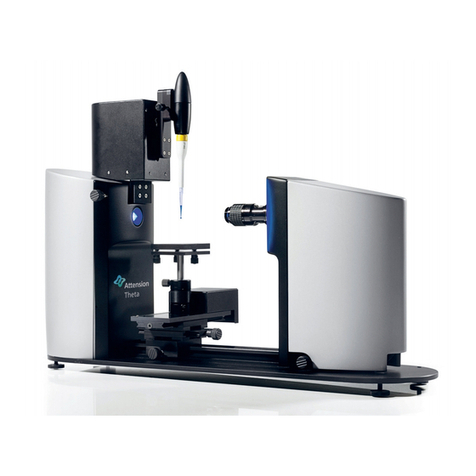
[ Attension®| KSV NIMA |QSense®] [5]
2.Safety
WARNING!
The safety requirements listed in this manual must be followed in order to avoid
personal injury and damage to the instrument. If the equipment is used in a manner
not listed in this manual, protection provided by the equipment may be impaired.
WARNING!
RISK OF ELECTRICAL SHOCK. Do not connect this instrument to electrical power if
the enclosure is damaged or any of the covers or panels are removed. Make sure the
voltage rating on the instrument matches the line voltage available. Make sure the
power cord is not damaged and it is properly connected to the instrument and a
power outlet with protective earthing. Make sure that the power cord is easily
accessible after the equipment has been installed and set at its working position.
WARNING!
RISK OF ELECTRICAL SHOCK OR FIRE HAZARD. The instrument has been
designed for indoor use only. Do not expose it to rain, snow or dust. During storage
or transport the instrument should be kept dry. Temperatures below 0˚C and above
70˚C should be avoided. Do not operate at ambient temperatures below 15˚C and
above 30˚C.
When handling flammable liquids, use a minimum sample volume that is required for
successful measurement.
Ensure prevention of Electrostatic Discharge (ESD) when handling flammable liquids.
Contact your local authorities for information on ESD prevention practices.
Do not heat flammable sample liquids to temperatures higher than T–25 °C where T
is fire point of the sample liquid.
WARNING!
RISK OF INJURY. Do not configure the instrument with parts that are not supplied
by Biolin Scientific and not intended to be used with Attension instruments. Do not
install substitute parts that are not described in this manual. Do not perform any
modifications to the product.
If dangerous liquids are used, adequate protection such as proper ventilation, safety
glasses, etc., should be used: refer to the safety information from the supplier and
general safety regulations in your country. Carry out appropriate decontamination if
equipment is exposed to hazardous material.
WARNING!
RISK OF BURNS. Exercise caution when touching heated sample vessels (optional).
The vessel surface will reach dangerous temperatures when heated. The vessels are
marked with hot surface warning symbol.
Platinum Wilhelmy plate/rod is an excellent catalyst for oxidation of methanol vapor.
This reaction is very exothermic. In experiments in which the Wilhelmy plate/rod is
positioned above reagent-grade methanol this reaction may cause dangerous
heating of the plate/rod. Be aware of this phenomenon and take appropriate
precautions.





























